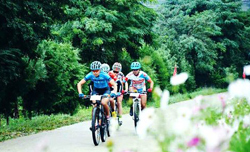Regions and cities
Jiuquan city
Updated: 2013-11-20( chinadaily.com.cn )
Name: Jiuquan city
Population: 1,100,000
Area: 192,000 square kilometers (73,746 square miles)
Ethnic group: Han
Administrative Division: 1district (Suzhou); 2 counties (Jinta, Guazhou); 2 autonomous counties (Subei Mongol autonomous county, Akesai Kazak autonomous county); 2 county-level cities (Yumen, Dunhuang)
Seat of the City Government: Municipal Square (Shizheng Guangchang), New City Proper
Useful Telephone Numbers: Tourist Complaints: 0937-2682507 Weather Forecast: 121 Zip Code Inquiry: 184
Bank of China Jiuquan Branch: N0.90, East Street, Suzhou district
China Post Jiuquan Branch: No.1, North Street, Suzhou district
Overview: Jiuquan city, covering a total land area of 192,000 square kilometers, is located in the west of the Hexi Corridor in Gansu province. It has a typical temperate continental climate with annual sunlight hours totaling 3,033 to 3,317, average temperature of 3.9~9.3 C, and 118-159 frost-free days annually. It has a population of about 1.1 million consisting of 40 ethnic groups, including Han, Hui, Mongolian, Kazak and Guyu. The city administrates one district, two county-level cities and four counties.
Location: Situated in the northwest of Gansu province, Jiuquan neighbors Zhangye in the east within the province. It is also bordered by Qinghai province in the south, Xinjiang Uygur autonomous region in the west and Inner Mongolia and Mongolia in the north.
History: Since extremely long ago, this area had been inhabited by nomads of several ancient ethnic minorities in northwestern China. It was until the early ages of the Western Han Dynasty (206BC-24AD) that vast land west of the Yellow River including Jiuquan was entirely put into the regnal territory. The famous Silk Road stretched through the city and it had been the vital pass linking Central China with Central Asia and Europe.
Physical Features: Basically, the terrain of Jiuquan is higher in the south, lower in the north and slopes downward from southwest to northeast. Offshoots of the Qilian Mountains occupy the south part of the city. The central land of Jiuquan distributes basins, and the Gobi area is mainly distributed in its north.
Climate: Enjoying a continental desert climate in temperate zone, the city is dry and seldom rainy throughout the year. The winter is chilly and summer is hot, the spring is arid. Wind blowing with sands often happens in spring and autumn. Temperature difference varies greatly during a day. It has slim rainfall during the whole year, mainly falling during July to October.
Resources: Jiuquan city boosts abundant wind and solar resources. It's estimated that the theoretical total volume of the city's wind power is about 150 million kWs. Total land area utilizing wind power is almost 10,000 square kilometers, accounting for 5.15 percent of the city's total area. The wind power density at a height of 10 meters is more than 250~310 watts per square meter. The city's water resources for utilization total 2.9 billion cubic meters.
The city has extensive grain, cotton and vegetable resources. It is a national commercial grain and cotton base, fruit and vegetable base, and melon and vegetable seeds export base. It has five explored mining belts featuring 572 mining spots, 92 mineral deposits and 48 minerals.
In the city, there are 1,153 scenic relic spots, including 14 national relic heritages and 208 provincial relic heritages. Among them, 98 scenic spots have been explored for domestic and foreign tourists, such as the Dunhuang Mogao Grottoes, the Crescent Spring, the relic site of the Western Han Dynasty (206BC-AD24), and the Jiuquan Satellite Launch Center.
Economy: In 2011, the city's total production value reached 48.15 billion yuan ($7.9 billion), a year-on-year increase of 15.5 percent. This figure includes 6.2 percent from the primary industry's increase of 5.9 billion yuan, 18 percent from the second industry's increase of 25.19 billion yuan, and 15.3 percent from the tertiary industry's 17.06 billion yuan.
The city's fiscal revenue exceeded 6 billion yuan in 2011, an increase of 18.8 percent over the previous year. Fixed assets investments reached 56.39 billion yuan, a year-on-year increase of 28.6 percent. The city's retail income for consumption goods reached 10.52 billion yuan, a year-on-year increase of 20.2 percent; the disposable income for urban residents was 17,265 yuan per year, a 14.3-percent increase.
Social undertakings: Jiuquan city invested 5.56 million yuan in the city's science and technology undertakings in 2011, an increase of 22.7 percent over 2010. Total applied patents in 2011 reached 481. Altogether, 137 patent applications were granted, including 63 invention patents. The city welcomed 182 new science and technology achievements during the year.
Enrolled students in 2011 reached 6,452 for higher education institutions, with an enrollment rate of 77.2 percent of all applicants. By the end of 2011, there were about 482,000 books in public libraries in the city. It also had 988 medical and public health organizations with 2,223 registered doctors and assistants to doctors, 62 more than in 2010. In provincial and higher level sports events, the city earned 95 medals, including 27 gold, 40 silver and 28 bronze. The city hosted 115 sports contests in 2011, with 105,000 people competed.


